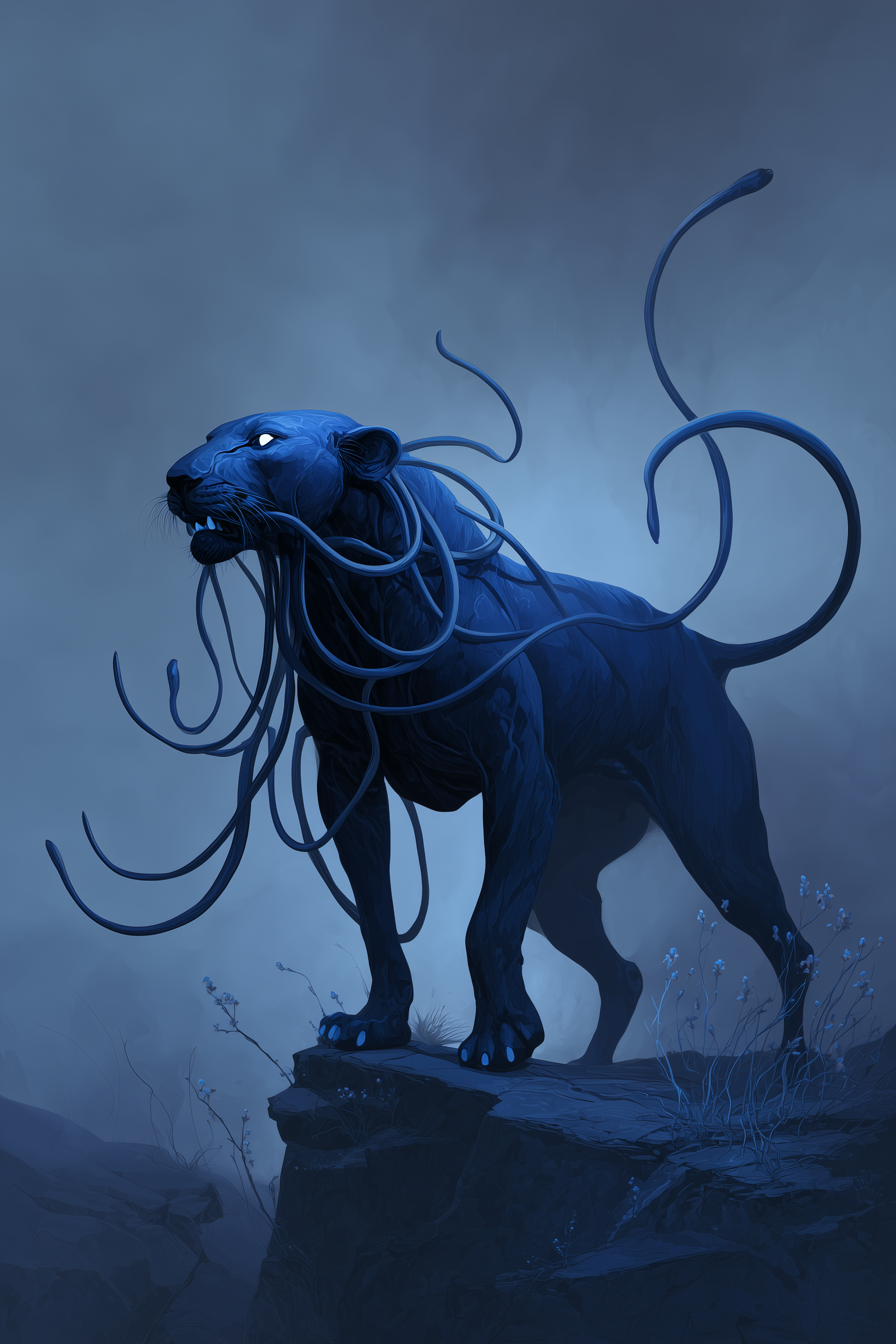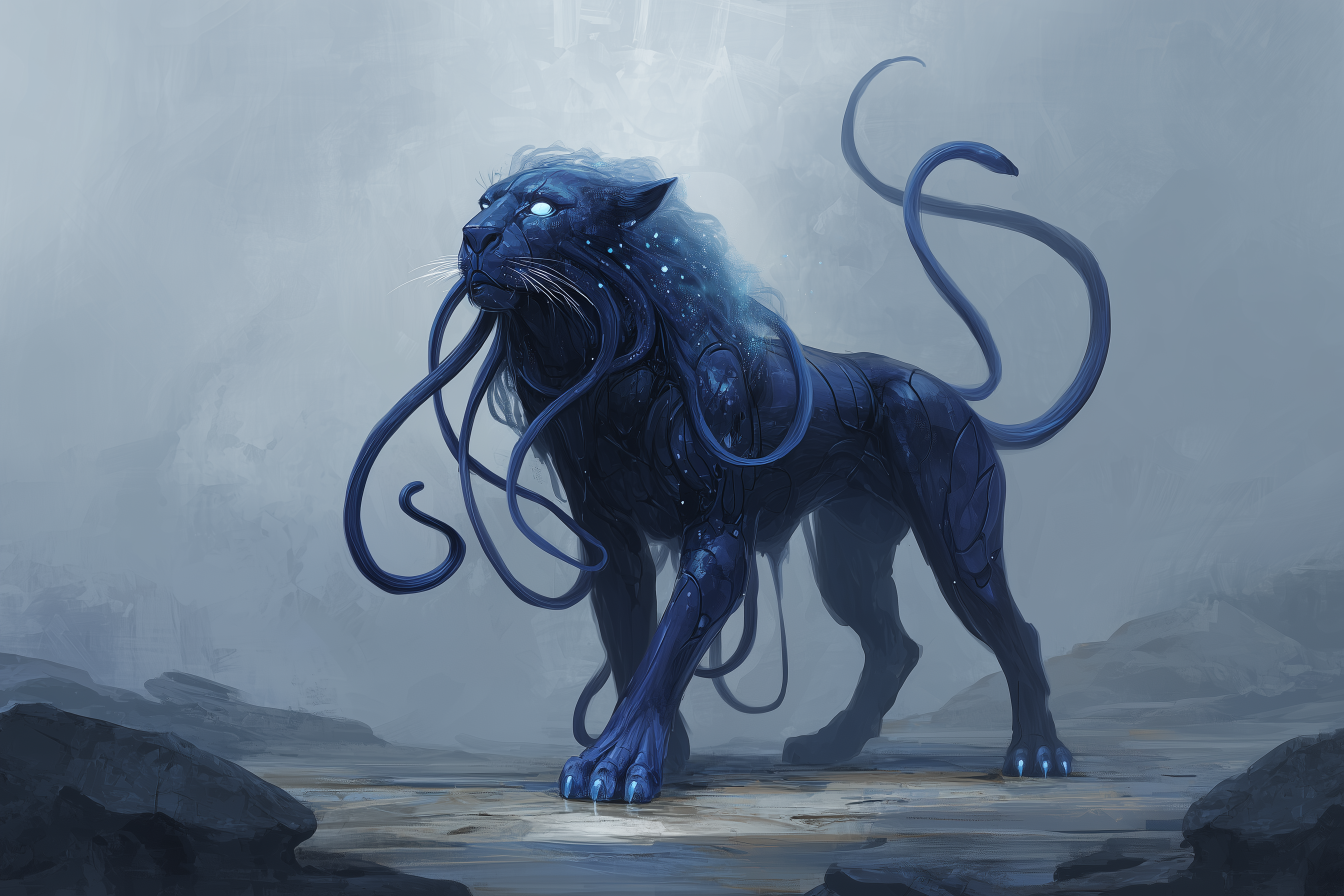Akata, Spawn of the Void Beyond
“Akata: The deaf, tentacled space-lion that infects you with parasitic larvae and turns your corpse into its next zombie minion!”

An Akata resembles a grotesque, hairless blue lion, its pallid flesh stretched taut over corded muscle. Its most horrifying feature is its head—where a mane should grow, a nest of thick, twitching tentacles writhes constantly, reacting to unseen stimuli. Two longer, muscular tentacles trail from its haunches like prehensile tails, and its eyes are small, glassy, and eerily vacant. Its jaws are oversized, always slightly ajar, lined with jagged teeth—and within, it harbors a microscopic swarm of parasitic young, invisible to the naked eye.
Behavior
Akatas are instinct-driven predators, eerily silent and unsettlingly focused. Though deaf and barely intelligent, they exhibit pack behavior, coordinating through scent and subtle vibration. They stalk prey with a grim patience, emerging from hiding only to strike quickly and savagely. Despite their monstrous appearance, Akatas show no signs of pain or fear, making them relentless once engaged. They do not flee—only kill or die.
Habitat
Originally from a dead, alien world, Akatas are now found in asteroids, crashed spacecraft, or ancient ruins where their hibernation cocoons remain undisturbed for centuries. Their cocoons—tough, metallic husks spun from their own secretions—are often buried deep beneath the surface of remote environments. Once active, they adapt to any terrestrial environment, though they avoid large bodies of salt water, which is lethal to them.
Modus Operandi
Akatas seek humanoid hosts to serve as incubators for their parasitic offspring. Their “void bite” infects victims with a horrific disease known as Void Death, which slowly drains life and eventually reanimates the corpse as a Void Zombie. Once a population is infected, Akatas allow the disease to spread naturally, turning isolated communities into undead breeding grounds. They hibernate again only when food becomes scarce, waiting in their unbreakable cocoons for new prey to wander close.
Motivation
Devoid of culture, language, or higher reasoning, Akatas exist for a single purpose: survival through infestation. Whether by ancient biological imperative or the echo of some long-dead alien will, they are driven to spread their kind. Their behavior is not evil by intent—but the results are nightmarishly catastrophic. Wherever an Akata walks, the dead do not rest.
Akata 5e
Akata, Pathfinder
Akata

Medium aberration, chaotic evil
Armor Class 13 (natural armor)
Hit Points 36 (8d8)
Speed 40 ft., climb 20 ft.
| STR | DEX | CON | INT | WIS | CHA |
|---|---|---|---|---|---|
| 14 (+2) | 15 (+2) | 16 (+3) | 3 (–4) | 12 (+1) | 6 (–2) |
Saving Throws Con +5, Wis +3
Skills Stealth +6, Acrobatics +4, Climb +6
Damage Resistances fire
Damage Immunities cold, poison
Condition Immunities deafened, poisoned
Senses darkvision 120 ft., passive Perception 11
Languages —
Challenge 2 (450 XP)
Proficiency Bonus +2
Traits
Alien Physiology.
The akata is deaf and immune to effects that rely on sound, including thunder damage and spells such as shatter or dissonant whispers. It cannot be charmed or frightened by auditory means.
Hibernation Cocoon.
As an action, the akata can encase itself in a metallic cocoon. The cocoon has AC 17, 60 hit points, and immunity to fire and bludgeoning damage. While encased, the akata doesn’t age or require air, food, or water. It remains in stasis until a living creature comes within 10 feet or it takes fire damage, at which point it emerges over 1d4 minutes.
Void Infection (Bite Only).
A humanoid creature hit by the akata’s bite must succeed on a DC 13 Constitution saving throw or be infected with void death, a parasitic disease. While infected:
- The target takes 1d6 necrotic damage at the end of each long rest.
- After three failed saves (made at the end of each long rest), the creature dies and rises in 1d4 hours as a Void Zombie under the DM’s control.
- The disease can be cured by a lesser restoration or remove curse spell.
Saltwater Vulnerability.
Salt water acts as acid to akatas. A direct splash (at least 1 pint) deals 3 (1d6) acid damage. Full immersion deals 14 (4d6) acid damage at the start of each of the akata’s turns.
Actions
Multiattack.
The akata makes one Bite attack and two Tentacle attacks.
Bite. Melee Weapon Attack: +4 to hit, reach 5 ft., one target.
Hit: 6 (1d8 + 2) piercing damage, and the target must make a DC 13 Constitution saving throw against Void Infection.
Tentacle. Melee Weapon Attack: +2 to hit, reach 10 ft., one target.
Hit: 4 (1d6 + 1) bludgeoning damage. If the target is a creature, it must succeed on a DC 12 Strength saving throw or be pulled 5 feet toward the akata.
Tentacular Lash (Recharge 5–6).
The akata whips its head-tentacles in a vicious flurry. Each creature within 10 feet must make a DC 13 Dexterity saving throw. On a failed save, a creature takes 10 (3d6) bludgeoning damage and is knocked prone. On a success, the creature takes half damage and remains standing.
Combat Tactics
- Ambush Hunter. Akatas favor ambushes, often lying in wait in cocoons or using high vantage points to drop on prey.
- Target Isolation. They prioritize humanoids, especially isolated or lightly armored individuals, to maximize the chance of infecting them with void death.
- Pack Efficiency. When encountered in groups, akatas coordinate attacks to swarm a single target and cycle between lash and bite actions, focusing on infection over brute force.
Variant: Void Zombie
When a humanoid dies from void death, it returns as a Void Zombie under the DM’s control. Use the Zombie stat block with these changes:
- Speed increases to 30 ft.
- Undead Fortitude is replaced with the following attack:
Tongue Strike. Melee Weapon Attack: +3 to hit, reach 10 ft., one target.
Hit: 6 (1d6 + 3) piercing damage, and the target loses 2 Strength from blood drain.
Void Zombies serve their parent akata instinctively, attacking living creatures and defending hibernation cocoons until destroyed.
Akata

This hairless blue lion has twin tentacular tails. Dozens more thick tentacles quiver and twitch where its mane should be.
[This content was created for the Pathfinder rules by Paizo Publishing LLC and is part of the Pathfinder RPG product line.]
Source: Pathfinder d20pfsrd.com
| Akata CR 1 |
| XP 400 N Medium aberration Init +6; Senses Darkvision 120 ft., Scent; Perception +1 |
| DEFENSE |
| AC 13, touch 12, flat-footed 11 (+2 Dexterity, +1 natural) hp 15 (2d8+6) Fort +3, Ref +2, Will +4 Defensive Abilities no breath; Immune cold, disease, poison; Resist fire 30 Weaknesses deaf, vulnerable to salt water |
| OFFENSE |
| Speed 40 ft., Climb 20 ft. Melee bite +2 (1d6+1 plus void bite), 2 tentacles 3 (1d3) |
| STATISTICS |
| Strength 12, Dexterity 15, Constitution 16, Intelligence 3, Wisdom 12, Charisma 11 Base Atk +1; CMB +2; CMD 14 (18 vs. trip) Feats Improved Initiative Skills Acrobatics +6 (+10 Jump), Climb +9, Stealth +10*; Racial Modifiers +8 Climb SQ hibernation |
| SPECIAL ABILITIES |
| Deaf (Ex) Akatas cannot hear. They are immune to spells and effects that rely on hearing to function, but they also cannot make Perception checks to listen. Hibernation (Ex) Akatas can enter a state of hibernation for an indefinite period of time when food is scarce. When an akata wishes to enter hibernation, it seeks out a den and surrounds itself in a layer of fibrous material excreted from its mouth ‘these fibers quickly harden into a dense, almost metallic cocoon. While hibernating, an akata does not need to drink or eat. The cocoon has hardness 10 and 60 hit points, and is immune to fire and bludgeoning (including falling) damage. As long as the cocoon remains intact, the akata within remains unharmed. The akata remains in a state of hibernation until it senses another living creature within 10 feet or is exposed to extreme heat, at which point it claws its way to freedom in 1d4 minutes as its cocoon degrades to fragments of strange metal. Salt Water Vulnerability (Ex) Salt water acts as an extremely strong acid to akatas. A splash of salt water deals 1d6 points of damage to an akata, and full immersion in salt water deals 4d6 points of damage per round. Void Bite (Ex) Akatas hold hundreds of invisibly small larval young within their mouths, spreading these parasitic creatures to hosts through their bite. Only humanoids make suitable hosts for akata young – all other creature types are immune to this parasitic infection. The disease itself is known as void death. Disease (Ex) Void Death: Bite – injury; save Fort DC 12; onset 1 hour; frequency 1/day; effect 1d2 Dexterity and 1d2 Constitution damage. An infected creature who dies rises as a void zombie 2d4 hours later; cure 2 consecutive saves. |
| ECOLOGY |
| Environment any Organization solitary, pair, or pack (3-30) Treasure standard |
Akatas hail from a strange, distant planet that long ago succumbed to a cataclysmic end. Countless akatas clung to fragments of the dead planet, entering hibernation and riding these asteroids until they eventually crashed upon a new planetakatas cocoons protected them from the impact, and they soon awoke to seek out suitable hosts to spawn their young. Left untended, an akata scourge can quickly grow into a significant threat. A typical akata stands 3-1/2 feet tall and weighs 400 pounds.
| Variants Void Zombies (CR +1): A humanoid killed by void death becomes a void zombie. A void zombie is a Zombie, Fast with a secondary ‘tongue’ attack (actually the larval akata’s feeding tendril) Speed: Increase the base creature’s land speed by 10 feet. Defensive Abilities: A void zombie does not gain DR 5/slashing. Attacks: A void zombie gains a secondary tongue attack for 1d6 damage. This follows normal rules for a secondary natural attack. Special Attacks: A void zombie gains the following special attacks. Quick Strikes (Ex) Whenever a void zombie takes a full-attack action, it can make one additional slam attack at its highest base attack bonus. Blood Drain (Ex) If a void zombie hits a living creature with its tongue attack, it drains blood, dealing 2 points of Strength damage before the tongue detaches. Special Qualities: A void zombie does not gain the staggered special quality. |
Section 15: Copyright Notice – Bestiary 2
Pathfinder Roleplaying Game Bestiary 2, © 2010, Paizo Publishing, LLC; Authors Wolfgang Baur, Jason Bulmahn, Adam Daigle, Graeme Davis, Crystal Frasier, Joshua J. Frost, Tim Hitchcock, Brandon Hodge, James Jacobs, Steve Kenson, Hal MacLean, Martin Mason, Rob McCreary, Erik Mona, Jason Nelson, Patrick Renie, Sean K Reynolds, F. Wesley Schneider, Owen K.C. Stephens, James L. Sutter, Russ Taylor, and Greg A. Vaughan, based on material by Jonathan Tweet, Monte Cook, and Skip Williams.

 Buy me a coffee
Buy me a coffee